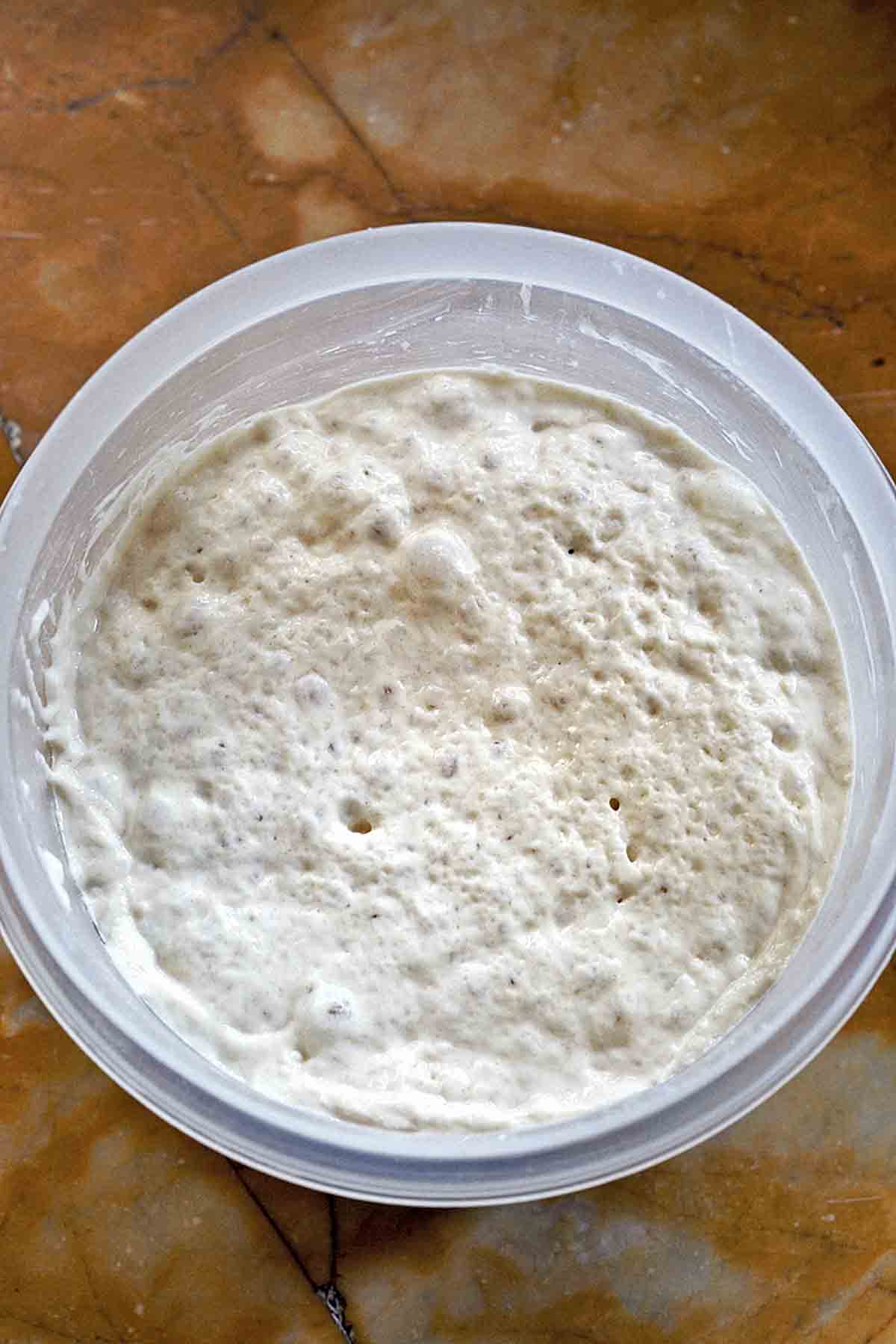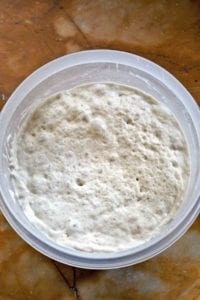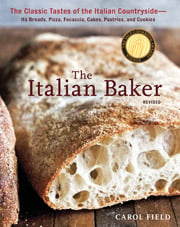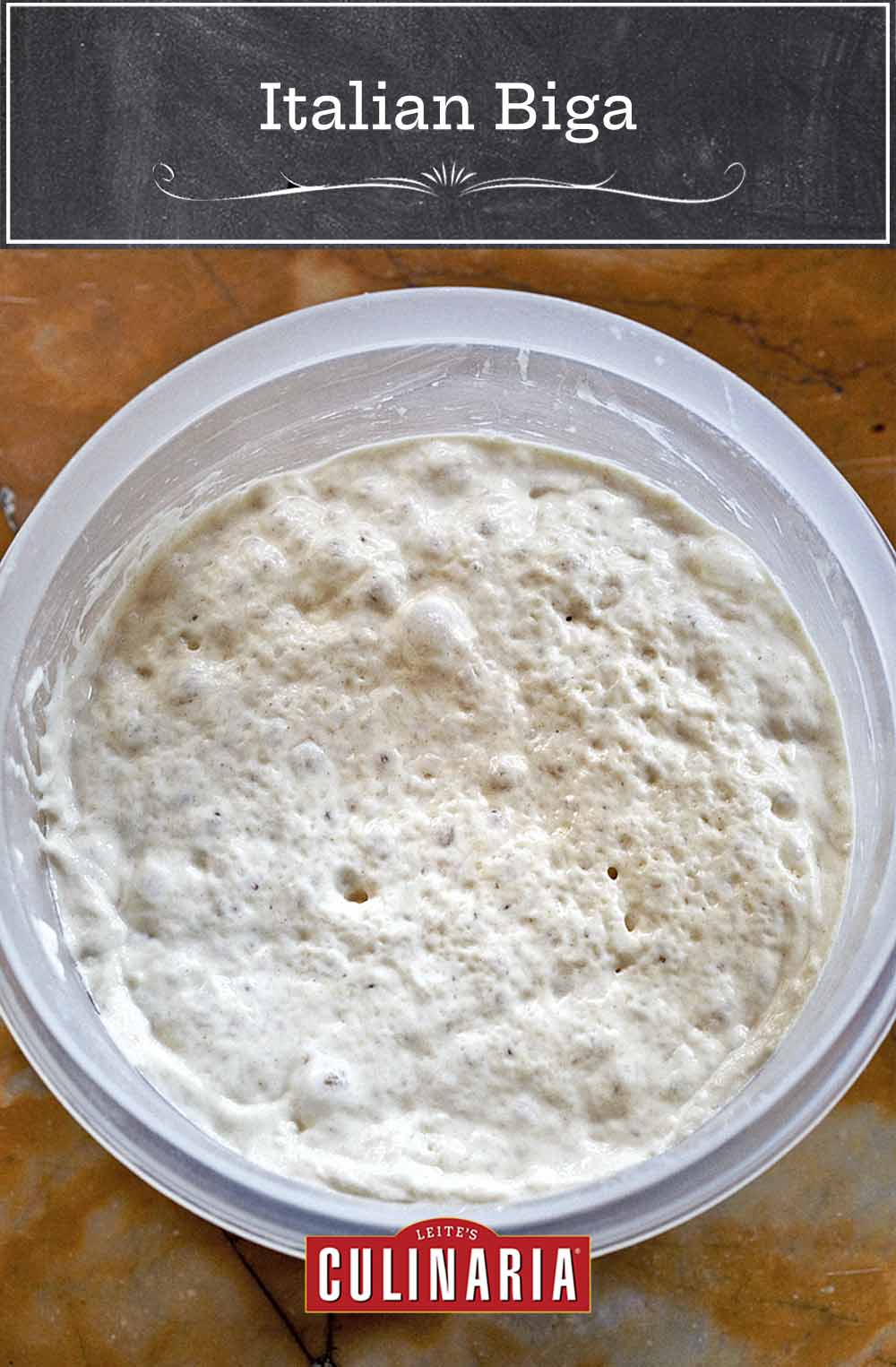
Many of the recipes for classic regional breads, such as this ciabatta recipe, begin with a starter dough made from small amounts of flour, water, and yeast allowed an initial fermentation. The starter, known as biga in Italy, or bighino when in small amounts, not only gives strength to what in Italy are weak flours, it also produces a secondary fermentation from which come the wonderful aroma, natural flavor, and special porosity of the final loaves and wheels of bread.
The important point about a biga is that the breads made with it develop a wonderful taste because their risings are long and bring out the flavor of the grain. Another benefit is that the loaves remain fresher and taste sweeter than those made with large amounts of commercial yeast.
In Italy, bakers use dough from the previous day’s baking to start a new dough. I keep some starter on hand at all times; by having it around, I can decide to make pane pugliese or ciabatta in the morning and have it for dinner that night. Because the first biga must come from somewhere, though, you may make it following the instructions below. It’s remarkable. It freezes very well and needs only about 3 hours at room temperature until it is bubbly and active again, or it can be refrigerated for up to 5 days.–Carol Field
LC Obliged to Biga Note
Behind each and every memorable bite of proper Italian bread we’ve daintily nibbled, hungrily inhaled, or otherwise somehow consumed, we have a biga to thank. So we’re feeling much obliged to Carol Field for this recipe. Nonna not included.

Italian Biga
Ingredients
- 1/4 teaspoon active dry yeast
- 1/4 cup warm water
- 3/4 cup plus 4 teaspoons water, preferably bottled spring water, at room temperature
- 2 1/3 cups unbleached all-purpose flour
- Vegetable oil, for the bowl
Instructions
- Stir the yeast into the 1/4 cup warm water and let stand until creamy, about 10 minutes.
- Stir the spring water into the creamy yeast mixture, and then stir in the flour, 1 cup at a time. If mixing by hand, stir with a wooden spoon for 3 to 4 minutes. If mixing with a stand mixer, beat with the paddle at the lowest speed for 2 minutes. If mixing with a food processor, mix just until a sticky dough forms.
- Transfer the biga to a lightly oiled bowl, cover with plastic wrap, and let rise at cool room temperature for 6 to 24 hours, until the starter is triple its original volume but is still wet and sticky. (The bakers I admire most advise 10 to 11 hours for the first rise, but others are very happy with the 24 hours it takes for dough to truly become yesterday’s dough, and if you like sour bread, allow your biga to rest for 24 to 48 hours or even 72 hours.)
- Cover and refrigerate or freeze the biga until ready to use. (If refrigerating the biga, use within 5 days. If freezing the biga, let it rest at room temperature for about 3 hours until it is bubbly and active again.) When needed, scoop out the desired amount of biga for your recipe and proceed. I strongly recommend weighing the biga rather than measuring it by volume since it expands at room temperature. If measuring by volume, measure chilled biga; if measuring by weight, the biga may be chilled or at room temperature.

Nutrition
Nutrition information is automatically calculated, so should only be used as an approximation.
Recipe Testers’ Reviews
This is a perfectly suitable starting point for most any bread which uses a starter. I bake bread several times a week and it’s nice to have this handy. Sometimes I add this to a bread dough which doesn’t call for a starter just for the added flavor.












Hi Angie,
When feeding a biga, do you combine the flour and water together first, or just put them in separately? Yes, I’m new to bread baking.
Tom
You can add them each directly to the biga, Tom. Good luck!
Thanks!
You’re welcome, Tom.
This is wonderful!
If I want to make bread every day and just use leftovers to make the next day’s bread, how would I go about doing that? Make 300g extra dough and just set it aside after every first rise? Does it need to be kept cool?
Thanks!
CL, you can keep extra biga in the fridge for up to 5 days, so if you are baking every day, then you’ll be getting through any extra biga well within that time frame. You could make several days’ worth and refrigerate or freeze if you don’t want to be making a batch every other day.
Hello! I made my first-ever baking attempt by trying to make this biga. And I got… nada! I followed the recipe to the letter, and left it overnight (65F in the house), and she didn’t rise at all. And I see others’ pictures here as it being liquid-y, mine was dry (basically), it was almost exactly a dough. Not like the bubbly, wettish mixture I see that others have (and your first picture at the top of the recipe). Not sure what I did wrong? I followed the recipe amounts exactly.
Any ideas?
There are a few things that could have gone wrong, Michael. First, is your yeast fresh? When you dissolved it in the warm water was it bubbling or foamy? Also, you have to be careful not to use water that is hot or you can kill the yeast. With regards to the dryness of the dough, did you measure your flour and water by volume or weight? The dough should be sticky after mixing it.
For the first attempt I measured by volume. I realized that mistake after I posted my comment. 🙂 My second attempt is by weight, but I am using packaged yeast. Fortunately I can get fresh yeast right nearby. The picture is attempt number two, but with about 50 ml more water, as it was still dry. But I realize now that I need fresh yeast. So it is operator error. I’m going to let this one rise and get fresh yeast and try attempt 3. I know the issue is me, not the recipe. I love it! Thanks for the quick answer. Will reply later again with results.
Michael, before you run out to the store, you don’t need fresh yeast. This should work with packaged yeast. I only meant that you want to make sure it’s still active (ie. bubbles or foams in step 1). My apologies for the confusion.
Hey Angie,
No problem at all! So that’s how you tell that the yeast is active? I have packaged (active dry) and she don’t bubble! But I simply used a full package (7g) and it worked. My biga came out great, as did my sfilatino!
Wonderful, Michael! I’m so pleased that this worked out for you. The additional yeast likely gave it the boost it needed, but yes, when you dissolve the yeast in water, if it doesn’t foam or bubble, it’s generally not active anymore and your best bet is to get some new yeast.
I have been having problems with biga (i m living in the country that is hot and humidity average room temperature is 28-37
Have been trying many attempts on bagels
Here are afew examples
1. Biga rest in room temp 16 -24hrs biga triple the size but starting to drop 1/5 some day drop half , i make bagel dough rest 1 hr then shape 5ps of bagel i rest another hr after i shape them then i poached the bagel then bake and it sometimes works.
Another 5 pcs i rest them overnight in refrigerator. Next day i let them sit in room temp for an hr then poached and bake they all gone flat!
Then i try rest my biga in fridge 24 hr ( no rise)
Another attempt i try rest in fridge and befor i use i leave the biga at room temp for 3-4 hrs befor use
2. Biga rest in fridge 18c 16hrs no rise what is the best temperature to rest biga in
3. My country is hot and humid and i want to bake bagel everyday please suggest how i should rest my biga like which temperature and how long
Paula, your climate is definitely making it difficult! As soon as your biga has tripled you should either use it or refrigerate it. Given how warm it is, this may be as short as 6 hours. You may also need to play around with the amounts of other ingredients in your bagel recipe.